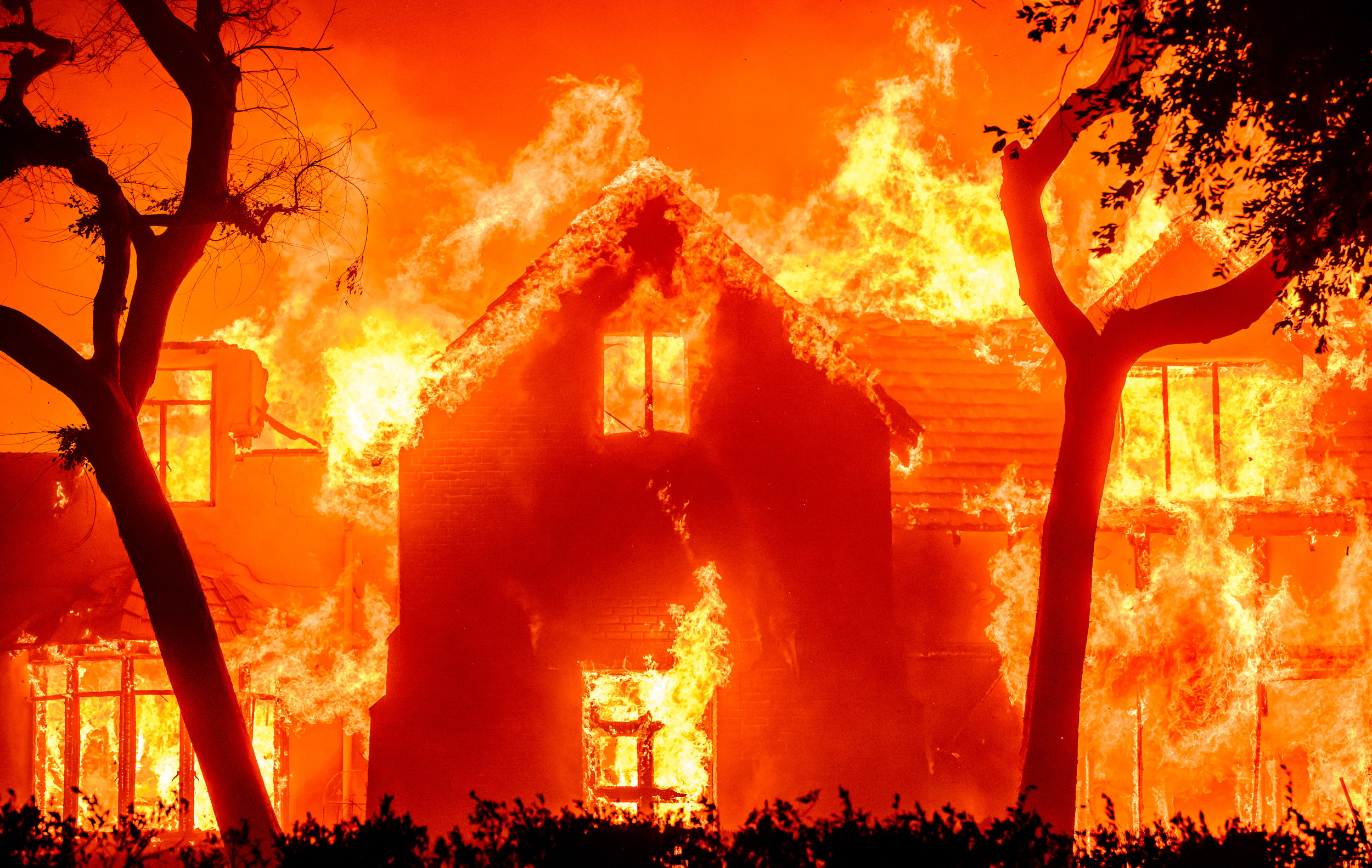
Climate change is posing an existential threat to the property insurance market in the U.S., as more frequent and severe natural disasters are forcing carriers to face higher costs—which can end up being passed on to homeowners.
Over the past five years, a series of devastating hurricanes, wildfires and floods have caused insurers in disaster-prone states like Florida and California to either go bust or cut coverage in the most vulnerable areas, in an attempt to avoid climbing costs potentially outweighing profits.
According to an analysis by SEO Amsterdam Economics cited by Insure Our Future, over one-third of weather-related insured losses over the past two decades, totaling $600 billion, can be attributed to climate change.
“The insurance crisis is the canary in the coal mine for the climate crisis. And the canary is dying,” Dave Jones, a former insurance commissioner of California who is now director of the Climate Risk Initiative at UC Berkeley’s Center for Law, Energy and the Environment, told Newsweek.
“I think some Americans have been in denial about the climate crisis, but you can’t deny what you can see with your eyes and what you experience in your wallet,” he said. “We’re having more extreme and severe weather-related events that are killing more people, injuring more people, damaging more property and causing insurance companies to jack up rates and write less insurance.”
And yet, some of the biggest insurers in the U.S.—including State Farm and Berkshire Hathaway—have significant investments in the fossil fuel industry and insure big emitters, even as studies have proven that nonrenewable energy sources such as coal, oil and gas are exacerbating the threat posed by natural disasters.
“Why are they investing in the very industries whose emissions are their major driver of global temperature rises, which is driving the catastrophic events, which is causing the insurance company losses and causing the insurer companies to stop writing insurance and to jack up prices? It makes no sense,” Jones said.
Newsweek contacted State Farm via email on Thursday for comment, but did not receive a response; we have also contacted Berkshire Hathaway Specialty Insurance, a subsidiary, via email.
How Much Money Have Insurers Invested in Fossil Fuels?
A recent survey by The Wall Street Journal shows that more than half the country’s 236 property and casualty insurers with fossil fuel holdings cut their investment in that industry between 2014 and 2023, as the impact of climate change became clear.
But some big players in the property and casualty insurance market—including State Farm and Berkshire Hathaway—are still betting on fossil fuel-related investments, effectively offsetting the divesting made by smaller companies.
According to the WSJ, insurers in the country reduced the share of their portfolios dedicated to fossil fuels to a median 1.8 percent in 2024 from 3.4 percent a decade earlier. But new investments from some of the biggest companies in the country have gone against this trend.
State Farm invested nearly $4.8 billion in stocks and bonds of gas and fossil fuel giants such as Chevron, Diamondback Energy and Exxon Mobil between 2014 and 2024, increasing its share of fossil-fuel companies in its $142.7-billion portfolio to 3.6 percent from 2.6 percent in the same decade, according to the WSJ.
The newspaper also reported that, in 2023, Berkshire’s insurers spent $39.9 billion on oil, gas and coal securities, increasing its share of fossil fuels to more than a fifth of their overall $183 billion in holdings.
The two companies together brought the U.S. insurance industry’s overall exposure to fossil fuels to 4.4 percent of their portfolios from 3.8 percent between 2014 and 2024.
In 2023, the renewable energy insurance market was still under 30 percent of the size of the fossil fuel insurance market. According to an internal analysis by Insure Our Future, AXIS Capital, Aviva, and Munich Re are the only major insurers writing more direct premiums for renewable energy than fossil fuels.
According to data from S&P Global, U.S. insurers in 2019 had investments for more than $500 billion in fossil fuel-related assets—and they are making good profits out of these. The Center for International Environmental Law (CIEL) said that what it considers “the top insurers of fossil fuel businesses” in the country earned $5.2 billion from underwriting in 2023, the latest year for which data was available.
CIEL reported that State Farm—the largest home insurer in California, a state that has seen several major insurers, including State Farm, cut coverage in recent years due to growing risk—has invested more than $6 billion in upstream oil and gas producers through its parent company, State Farm Mutual.
According to Fossil Free Funds, a website which collects data on U.S. mutual funds and exchange-traded funds (ETFs) that avoid fossil fuel investments, other companies including Berkshire Hathaway, USAA and AIG have also invested billions in the fossil fuel industry.
Newsweek contacted USAA and AIG by email for comment on Thursday.
Mark Friedlander of the Insurance Information Institute (Triple-I) believes that the size of home insurers’ investment is overestimated, however. “Insurers primarily invest in bonds and fixed instruments. Few insurers invest in fossil fuels and these investments have generally been declining in recent years, accounting for approximately 4 percent of total industry investments,” he told Newsweek.
“However, some investment strategies of national insurers include fossil fuels to ensure they generate enough capital to pay high volumes of catastrophe claims. The industry is dedicated to keeping capital on hand for the long term so it can pay its claims.”
The home insurance industry in the U.S., overall, has $1.1 trillion in surplus capital, according to Triple-I data, “to pay claims for covered losses from personal and commercial policyholders,” Friedlander said.
The fossil fuel industry remains very profitable. A recent study by University College London (UCL) found that in 2022, the latest data available, such companies around the world netted nearly half a trillion U.S. dollars—$490 billion—in profits above their expectations.
What Impact Does This Have on Consumers?
For some insurance experts and consumer advocates, U.S. carriers are part of a vicious cycle undermining the stability of the country’s property insurance market.
On one side, insurers are investing in an industry that is still profitable and allows them to fatten up their reserves in a time of growing catastrophe exposure and likely higher claims. On the other side, these investments are accelerating climate change, fueling that same crisis that could force the entire sector to reinvent itself or face collapse—and has led to premium hikes and coverage cuts in recent years.
“Insurance companies get away with it because they’re shifting all those costs to consumers,” Carmen Balber, executive director of Los Angeles-based Consumer Watchdog, told Newsweek. “So they’re profiting from insuring fossil fuel companies, but when climate-driven weather events cause a catastrophe, they externalize all the costs,” she said.
“Consumers pay for insurance companies to exacerbate climate change in the form of rate hikes, nonrenewals and low-balled claims that deny them the benefits they’ve paid for, sometimes for decades,” she added.
Last year, when firefighters in California battled over 8,000 blazes which burned more than 1 million acres and destroyed thousands of homes and other structures, State Farm said it was no longer writing new policies in the state due to the surge in wildfires.
The company also cut coverage in many vulnerable parts of the state, sparking outrage when homeowners who had just faced a nonrenewal were then hit by the January wildfires around Los Angeles County.
Earlier this year, State Farm asked state regulators for another premium increase on top of a 17 percent emergency increase on its homeowner policies greenlit by the California Department of Insurance after the January wildfires.
In a statement, State Farm said that the increases were necessary to strengthen the company’s financial position in the state “as it is difficult to match price to risk in California.”
It is not just California—the entire country is facing the same threat, with different degrees of urgency. A study by the National Bureau of Economic Research found that average premiums jumped by more than 30 percent (13 percent adjusted for inflation) across the country between 2020 and 2023.
Experts think that home insurance premiums will continue rising across the country this year.
The result of premium hikes and reduced coverage is that a growing number of Americans are underinsured, while some have no coverage whatsoever. What happened in California and Florida over the past couple of years, with the states’ insurers of last resort ballooning in size as a result of carriers dropping coverage, showed that these programs are not ready to fill the void left by the private sector.
Should Insurers Be Forced To Divest?
“We have long called for the insurance industry to get out of the business of causing climate change,” Balber said. “Insurers should divest from fossil fuels and stop insuring the fossil fuel projects that are driving climate change.”
The first step in order to do so, Balber said, is full disclosure from insurers of their investments in the fossil fuel industry. “But insurance commissioners have been unwilling to make insurers disclose how deeply they are exposed,” she said.
“Insurance companies investing in and underwriting fossil fuel projects is like firefighters handing out flamethrowers. It doesn’t make sense to contribute to the harm you’re paying for.”
According to Balber, the industry should be required to face the climate threat by divesting and ending fossil fuel underwriting, and by promoting climate resilience measures like home hardening which make communities more sustainable.
Insurers, according to Jones, “are unwilling to address the root causes of the problem and believe it’s simply easier to jack up rates and write less insurance. They should transition out of their investments in oil and gas,” he said.
“We are marching towards an uninsurable future in this country because we’re not doing enough fast enough around climate change. And what that means then is that families, and individuals are going to increasingly find it difficult to afford to own a home in this country.”
Read the Full Interview With Dave Jones
What threat is the U.S. property insurance market facing?
“We have an insurance crisis throughout the United States, not just in California. Every state with varying degrees of severity is facing increased frequency and severity of climate-driven, weather-related catastrophes. And so insurance companies throughout the United States are raising rates and declining to renew and write insurance. That’s landing with different levels of acuity in different parts of the country based on the severity and frequency of the climate-driven events, but there’s no get-out-of-climate-change-free card in the United States.
“In California, the way it’s landed is with more severe wildfires and wildfires that burn increasing amounts of acreage. So what that’s meant is that insurance companies have suffered increased losses and face increased risk of loss. Because we’re not doing enough fast enough to transition from fossil fuels and other greenhouse gas-emitting industries.”
What role are insurers playing in finding a solution?
“[The current crisis] is not out of the hands of the insurance companies. There are many things that insurance companies can do to support the transition to net zero emissions.
“Insurance companies in the United States have over half a trillion dollars invested in the oil and gas industry. Why are they investing in the very industries whose emissions are their major driver of global temperature rises, which is driving the catastrophic events, which is causing the insurance company losses and causing the insurer companies to stop writing insurance and to jack up price? It makes no sense. One thing insurance companies could do, is transition out of their investments in oil, gas and coal.
“Insurance companies are also writing insurance for the oil and gas industry. So why are insurance companies in the United States writing insurance for the very industry whose admissions are causing an existential crisis for the insurance industry?
“They are unwilling to address the root causes of the problem and believe it’s simply easier to jack up rates and write less insurance. But that’s an explanation, not a justification for what they’re doing.”
What should insurers do instead of investing in fossil fuels?
“They should transition out of their investments in oil and gas. They should transition out of writing insurance for the oil and gas industry. There are many things the insurance industry can and shouldn’t do that they’re not doing.
“We are marching towards an uninsurable future in this country because we’re not doing enough fast enough around climate change. And what that means then is that families and individuals are going to increasingly find it difficult to afford to own a home in this country.
“And so, Jerome Powell, the chairperson of the U.S. Federal Reserve, testified before Congress the other month that because of the higher insurance pricing, the declining availability of insurance in many parts of the U.S., and because you need to have insurance in order to get a mortgage in the U.S. or to keep it, there are many parts of the country where you won’t be able to find insurance and you won’t be able get a mortgage, so you won’t be able own a home.
“The implications of what’s occurring here are very bad for the ability to purchase a home because if you can’t afford your insurance, you can’t get a mortgage, so you can’t afford to purchase a home unless you’re very, very wealthy. And we’re already seeing this.”
What do you expect to happen next in the U.S. property insurance sector?
“I think that we’re going to see more rate increases across the United States, both in rate regulated and nonregulated states.
“I think we’re going to see more nonrenewals and more declining to write insurance because the background risk keeps going up so that the background on risk is outpacing the price. And even if the price goes up, even at the highest price, insurers conclude that they can’t keep writing insurance. So that means more people are going to be pushed into what are called residual markets or fair plans. And I think what we need to figure out is how to shore up the fair plan.
“It is a rude awakening for many Americans. The insurance crisis is the canary in the coal mine for the climate crisis, and the canary is dying. And I think some number of Americans have been in denial about the climate crisis, but you can’t deny what you can see with your eyes and what you experience in your wallet.
“We’re having more extreme and severe weather-related events that are killing more people, injuring more people, damaging more property and causing insurance companies to jack up rates and write less insurance. And that’s hitting people in the wallet and making it impossible for some people to afford insurance and afford to own a home.”



